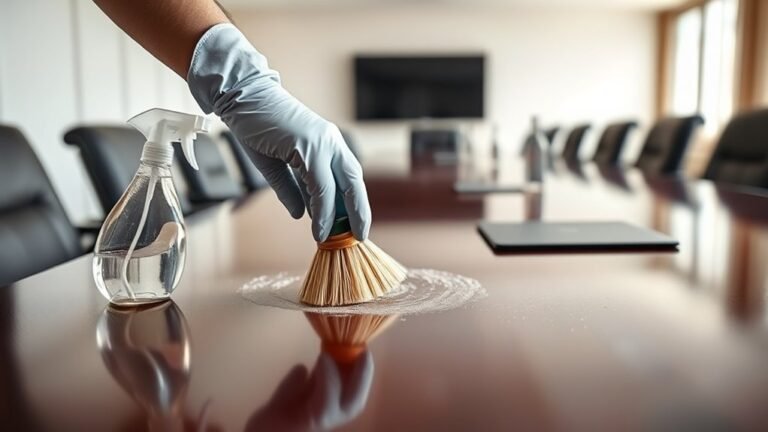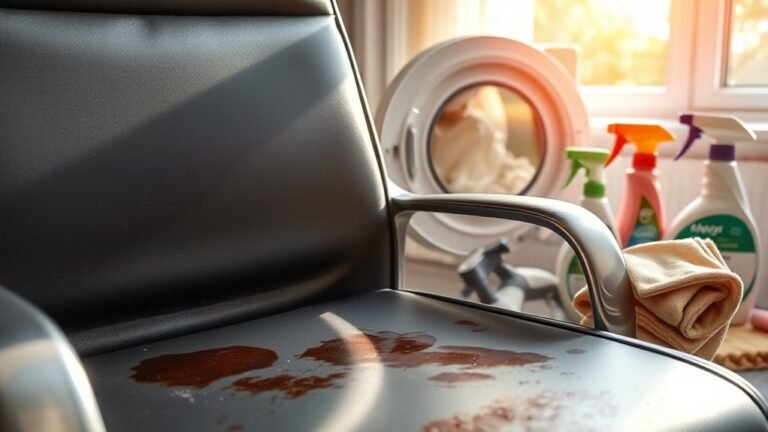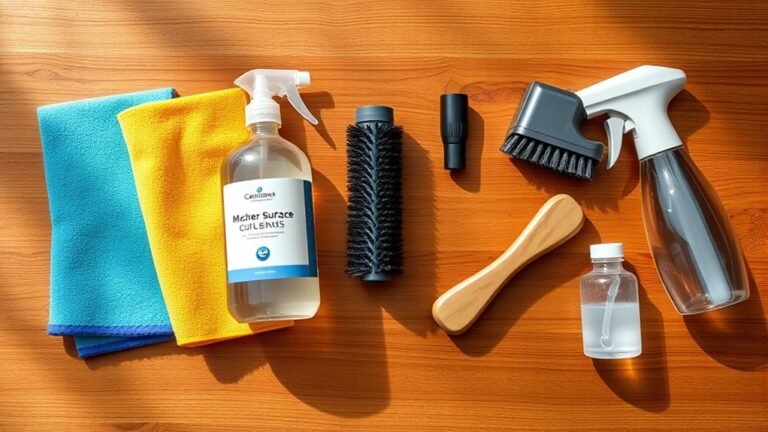Daily Maintenance Tips for Office Chair
To keep your office chair comfortable and long-lasting, dust it regularly with a microfiber cloth and clean spills promptly. Check and tighten screws to prevent wobbling, and apply a small amount of silicone spray or grease on moving parts for smooth action. Adjust the height and tilt daily for proper posture, ensuring your feet rest flat and your knees are comfy. Don’t forget to vacuum and protect the fabric to maintain freshness. If you want to make the most of your chair’s potential, there’s more you can do.
Cleaning and Dusting Your Chair

To keep your office chair looking its best, start by cleaning and dusting it regularly. You want to maintain that fresh, inviting space where you feel free to focus and create. Grab a microfiber cloth—it’s perfect for lifting dust without scratching surfaces. Gently wipe down every part of the chair, paying attention to crevices where dirt loves to hide. When it comes to removing stains, act quickly. Use a damp microfiber cloth with a mild cleaner, and blot rather than rub to avoid spreading the stain. This simple habit prevents grime build-up, keeps your chair looking sharp, and lets you enjoy your workspace without distractions. Staying on top of cleaning means more freedom to work comfortably, every day.
Inspecting and Tightening Hardware
After keeping your chair clean, the next step is to check its hardware regularly. Performing a thorough hardware inspection guarantees your chair stays sturdy and safe, giving you the freedom to move without worry. Focus on bolts, screws, and any visible fasteners. Over time, these can loosen due to constant use or movement. Don’t wait for a wobble or squeak—tightening bolts proactively prevents bigger problems down the line. Use the right tools to snug everything up, but be careful not to overtighten and strip the threads. By making hardware inspection and tightening bolts a simple habit, you’ll extend your chair’s lifespan and keep it feeling secure. It’s a small effort that pays off with lasting comfort and freedom in your workspace.
Lubricating Moving Parts

While inspecting hardware keeps your chair sturdy, lubricating moving parts guarantees smooth, quiet operation. To keep your chair moving freely, you’ll want to focus on the right grease application and choosing suitable lubricant types. Avoid sticky or thick greases that can attract dust and dirt.
Lubricate moving parts with the right grease to ensure smooth, quiet chair operation and prevent dirt buildup.
Here’s how to maintain your chair’s freedom of movement:
- Identify pivot points and joints needing lubrication.
- Use a lightweight silicone spray or white lithium grease for best results.
- Apply lubricant sparingly to avoid buildup.
- Wipe away excess lubricant to prevent grime accumulation.
Checking and Adjusting Chair Height and Tilt
Although it might seem simple, regularly checking and adjusting your chair’s height and tilt can prevent discomfort and improve your posture throughout the day. You want to find the perfect balance where your feet rest flat on the floor, and your knees are at a comfortable angle. Adjusting the height guarantees you maintain proper posture, reducing strain on your back and shoulders. The tilt function offers ergonomic benefits by allowing you to recline slightly, relieving pressure on your lower spine. Take a moment each day to test these settings, tailoring them to your body’s needs. This small habit grants you the freedom to work comfortably, staying energized and focused without unnecessary pain or tension.
Maintaining Upholstery and Fabric Care

Since your office chair’s upholstery is in constant use, keeping it clean and well-maintained is essential for both comfort and longevity. You want your fabric to feel fresh and look great, so practicing regular fabric protection and prompt stain removal is key. Here’s how you can easily care for your chair’s fabric:
Regular fabric care keeps your office chair comfortable, fresh, and looking great for years to come.
- Vacuum the upholstery weekly to remove dust and debris.
- Use a fabric protector spray to guard against spills and stains.
- Address stains immediately with a gentle cleaner suitable for your fabric type.
- Avoid harsh chemicals that can damage fibers or fade colors.
Frequently Asked Questions
How Often Should I Replace My Office Chair?
You should consider replacing your office chair when you notice clear replacement signs like sagging cushions, broken wheels, or discomfort despite adjustments. Typically, the average chair lifespan is about 5 to 7 years, but it varies based on use and quality. Don’t feel tied down to an old chair that limits your comfort or freedom—upgrading can boost your productivity and well-being, giving you the freedom to work without pain or distraction.
What Type of Office Chair Is Best for Back Support?
When choosing the best office chair for back support, you’ll want one with adjustable lumbar support to keep your lower back aligned and comfortable throughout the day. Make sure the chair height is easy to adjust, so your feet rest flat on the floor and your knees are at a right angle. This freedom to customize your seating helps prevent strain and keeps you feeling energized and supported while you work.
Can I Use a Standing Desk With My Office Chair?
Did you know people who alternate between sitting and standing can boost productivity by up to 45%? You can absolutely use a standing desk with your office chair. Just make sure your chair height adjustment syncs well with the desk’s height to stay comfortable. This way, you enjoy standing desk benefits like reduced fatigue and better posture, while still having the freedom to sit whenever you want. It’s all about balance and flexibility!
Are Ergonomic Chairs Worth the Investment?
You’re wondering if ergonomic chairs are worth the investment. Considering the ergonomic benefits, they’re designed to support your body, reduce strain, and boost comfort during long hours. When you do a cost comparison, the upfront price might seem high, but the freedom from pain and improved productivity often outweighs that. So, if you value your well-being and want to work without discomfort, investing in an ergonomic chair is definitely worth it.
How Do I Recycle or Dispose of an Old Office Chair?
When it’s time to part with your old office chair, you’ve got a few recycling options to keep in mind. You can check with local recycling centers to see if they accept furniture or parts like metal and plastic. If recycling isn’t available, explore disposal methods like donating it to charity or scheduling bulk waste pickup. You’ve got the freedom to choose the path that’s easiest and most eco-friendly for you.






